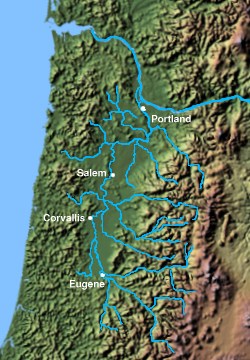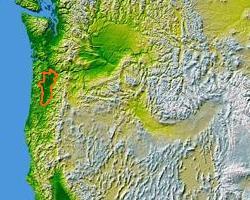Willamette Valley
|
|
The Willamette Valley is the region in northwest Oregon in the United States that surrounds the Willamette River as it proceeds northward from its emergence from mountains near Eugene to its confluence with the Columbia River. One of the most productive agricultural areas of the world, the valley was the destination of choice for the emigrants on the Oregon Trail in the 1840s. It has formed the cultural and political heart of Oregon since the days of the Oregon Territory, and is home to nearly 20% of Oregon's population (or 60% if the Portland area is included).
Description
The valley may be loosely defined as the watershed of the Willamette, bounded on the west by the Coast Ranges, on the east by the Cascade Range. It is bounded on the south by the Calapooya Mountains, which separate the headwaters of the Willamette from the Umpqua River valley. Because of the differing cultural and political interests, the Portland metropolitan area, as well as the Tualatin River valley, are often disincluded in the local use of the term.
The agricultural richness of the valley is considered to be in no small measure a result of the Missoula Floods, which inundated the valley approximately forty times between 15,000 and 13,000 years ago at the end of the last ice age. The floods were caused by the periodic rupturing of the ice dam of Glacial Lake Missoula, the waters of which swept down the Columbia and flooded the Willamette Valley as far south as Eugene. The floodwaters carried rich volcanic and glacial soil from Eastern Washington, which was deposited across the valley floor when the waters subsided.
During the 19th century, the valley was largely inhabited by bands of the Kalapuya tribe of Native Americans. The Hudson's Bay Company controlled the fur trade in the valley in the 1820s and 1830s. The first white settlements in the valley were at Oregon City and Champoeg. The first institution of higher learning on the West Coast, today's Willamette University, was founded in the valley at Salem by Jason Lee, one of the many Oregon missionaries that settled in the valley. Major cities in the valley today include Eugene, Salem (the state capital), Corvallis, and Albany. Interstate 5 runs the length of the valley linking its major communities.
The major agricultural products of the valley include many varieties of berries and vegetables. The valley also produces most of the grass seed, Christmas trees and hazelnuts sold in North America. But it is greenhouse and nursery stock that have become the biggest agricultural commodity in the valley.
In recent decades, the valley has also become a major wine producer, with multiple American Viticultural Areas (AVAs) of its own. With a cooler climate than California, the gently rolling hills surrounding the Willamette are home to some of the best pinot noir in the New World, as well as a high-quality pinot gris.
The valley includes five entire counties:
- Benton, Polk, Yamhill, and Washington.
as well as parts of four others:
External links
- OPB: Missoula Floods in the Willamette Valley (http://www.opb.org/programs/ofg/episodes/1001/missoula/index.php)
| State of Oregon | 
| ||
| Regions Columbia River Gorge and Plateau | Eastern Oregon | Inland Empire | Mt. Hood Corridor | Oregon Coast | Western Oregon | Willamette Valley | |||
| Counties | Largest cities (full list) | ||
| Baker | Benton | Clackamas | Clatsop | Columbia | Coos | Crook | Curry | Deschutes | Douglas | Gilliam | Grant | Harney | Hood River | Jackson | Jefferson | Josephine | Klamath | Lake | Lane | Lincoln | Linn | Malheur | Marion | Morrow | Multnomah | Polk | Sherman | Tillamook | Umatilla | Union | Wallowa | Wasco | Washington | Wheeler | Yamhill | Albany | Beaverton | Bend | Corvallis | Eugene | Grants Pass | Gresham | Hillsboro | Keizer | Lake Oswego | McMinnville | Medford | Milwaukie | Oregon City | Portland | Salem | Springfield | Tigard | Tualatin | West Linn | ||


